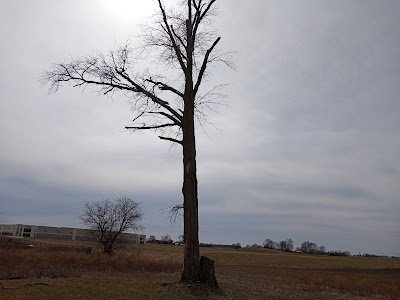Out of the various promises to "blast away" mosquitoes (as well as other insects) and "take back your lawn," usually accompanied by pictures of people blissfully frolicking in a sea of tamed and monocultured grasses, one ad stood out from the rest. It was so eye-catching and thought-provoking that I had to take a break from my usual posts on popular culture to comment on it here. Alongside the picture of a blood-filled mosquito stood the following declaration: "the only good mosquito is a dead one." What a statement!
The painting is rich in loaded imagery. The spirit of the country is symbolized by "Lady Columbia," who is dressed in a pure, flowing white garment as she strings telegraph wires across the landscape. In her other hand, she carries a school book and on her head she wears the starred "crown of empire." Behind her, trains, settlers, and farmers push westward, all forging ahead in the enterprise of spreading their definition of "civilization." Before them, those regarded as figures of savagery and wilderness -- native peoples and undomesticated animals like bears, foxes, and wolves -- are pushed into the shadows. Behind this imagery stood a political and cultural rhetoric that led to the near extermination of native peoples and wildlife. All in the name of "civilization" and, as the painting's title attests, "progress."
Over time, as Meider's research shows, the proverb was recycled regularly against whoever happened to be the enemy of the moment, losing none of its genocidal, racist heritage. During World War One, it was Germans; during World War Two, the Japanese; in the 1960s, the Vietnamese. Now, as my mailbox revealed not too long ago, we've reached the point that an insect has been plugged into "The Only Good X is a Dead X" equation.
As stated earlier, I am well aware of the toll mosquitoes take on humans, primarily as a vector for disease. However, is extermination the answer? While the ad I received might just be a marketer's attempt at humor, there are real efforts underway to eradicate mosquitoes. As recently reported in Time magazine, an experiment currently being run in the Florida Keys by biotech firm Oxitec involves genetically-modified male mosquitoes passing faulty genes along to female mosquitoes. If everything goes according to Oxitec's plan, all the resulting female offspring will die, leading to a precipitous crash in the mosquito population.
Even if a person hasn't read cautionary tales like Frankenstein or Jurassic Park, it's hard to see how this sort of project won't unleash unintended consequences. For one, what about the dragonflies, salamanders, and other creatures who eat mosquitoes throughout their life cycle? Will there be a population crash among those insects and animals, too, and then on up the food chain? The same can be said for the fogging and chemical treatments carried out by those mosquito and insect control services. The same spray or fog that eliminates mosquitoes will also kill bees, moths, butterflies, and all manner of other wildlife.
In the end, I'm still amazed at the slogan: "The Only Good Mosquito is a Dead One." It harkens back to the perceived struggle to conquer the wilderness in the name of civilization, except that having reached the Pacific -- Manifest Destiny was successful, since America now rules "sea to shining sea" -- the war has turned inward, with the frontlines being our yards and lawns and the enemies are the buzzing insects that dare intrude on our domestic bliss. In fact, if we were to update Gast's "American Progress" for the modern Manifest Destiny, Lady Columbia might carry a fogger and a vast tank of chemicals, with mosquitoes and coyotes in flight as suburbs and big box stores spring up in her wake. Times and technologies may change, but cultural mentalities seem to be a lot harder to alter. If this is progress, go ahead and let me off at the next stop.
Next time, I'll probably be back to form with a post on popular culture, maybe The Mandalorian as I have finally gotten a chance to watch it. As always, if you enjoyed this post, you might like some of my other writings, like my book Religion and Myth in the Marvel Cinematic Universe. Until next time, take care.





































